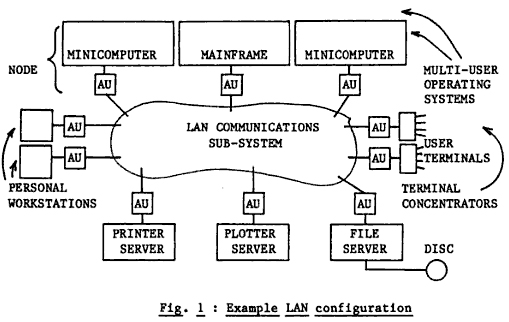
(image from 1986 LAN course guide via Google Books)
Before we can have an Internet of Things, we will need to have a LAN of things. Remember local area networks? They formed a key step in the development of the Internet: rather than everything being connected to the Internet, and communicating that way, LANs connected small handfuls of devices. Perhaps one of the devices had a connection to the outside world, but that may have not mattered much. Most of the utility of a LAN came from its local functionality. Thus, before we can build a useful (from a user perspective) Internet of Things, we need to learn to build useful LANs of Things.
A place to start understanding LAN of Things utility is by looking at what made actual LANs useful. Here's a definition of LANs from 1988:
"A local area network, LAN, is a communication and data storage system made from building blocks that can be added and shaped as required. They combine transmission, storage, and processing operations to meet specific user applications."
There are several points to this definition that are quite relevant to the current state of ubiquitous computing (and the Internet of Things):
- Devices are "building blocks" that serve specific functions. Printers, tape drives and modems all served specific functions in the early LAN ecology.
- They "combine transmission, storage, and processing operations." In other words, each device works standalone, but it is the combination of the devices that provides greatest value ("synergy" in the business language of 80s).
- Components are "added and shaped [...] meet specific user applications." This implies that not all LAN have the same components and that LANs are built as needed, rather than defined in its entirely beforehand.
In a post Peak MHz era we don't need to worry nearly as much about creating specialized devices to mitigate the cost of processing. However, functional specialization is still a valuable for helping people (users and designers) apply technology to specific use contexts.
If we look at books on The Internet of Things (I'm currently reading Interconnecting Smart Objects with IP) the examples of how the technology will be used has changed little since MIT's Auto-ID center was founded in the late 1990s. It's still focused on:
- Inventory control
- Home automation
- Logistics
- Energy management
- Etc.
This type of "useful alone -- even more useful with others" model applies to the ubicomp technologies underlying the Internet of Things, and is responsible for the slow adoption of these technologies. Metcalfe's Law almost always needs a jump start, and that's local utility. Thus, I think it's important to start thinking about what the highly localized uses of sparsely distributed technology can be.
- What can we do when there are only a couple of things with RFIDs in our house?
- What totally great service can be built on having two light switches that report their telemetry in the house?
- What totally valuable information can you tell me if I only wear my motion sensor every once in a while?
- What else is like this?
- How can we use these existing LANs of Things (cars, pets, UPC bar codes) and build networked services on them?




Recent Comments